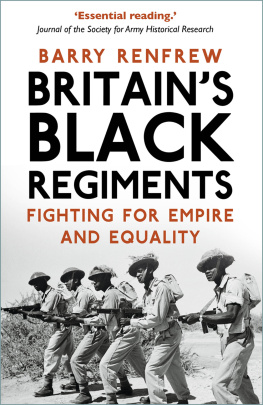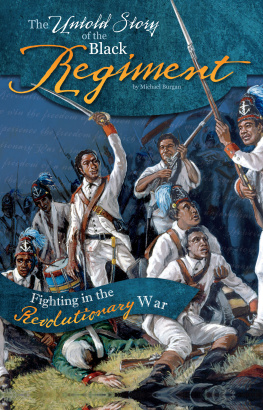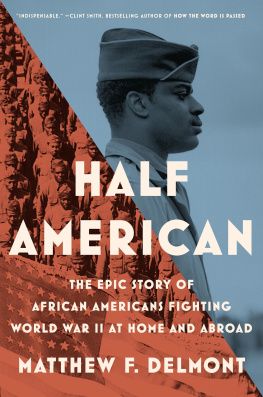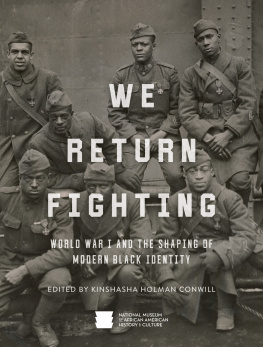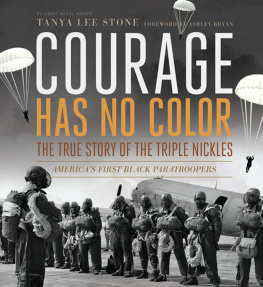

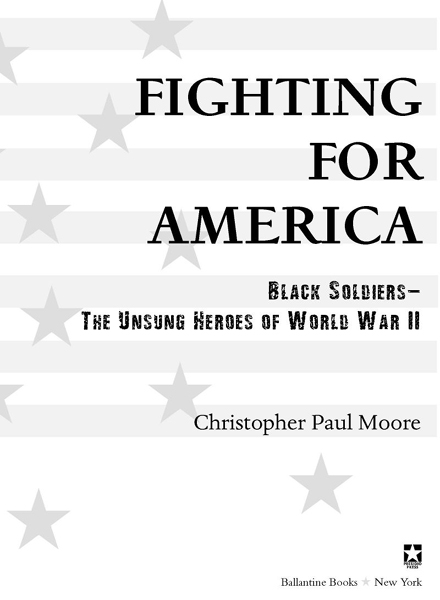
Table of Contents
TO
PFC. NORMA KATHERINE DEFREESE MOORE
AND SGT. WILLARD MORRIS MOORE:
THANK YOU FOR TEACHING ME
TO LOVE GOD, MY FAMILY, AND MY NEIGHBORS.
AND TO FIGHT FOR MY COUNTRY.

ACKNOWLEDGMENTS
In the making of this book, my first thanks goes to the angelic Catherine McKinley, who happened upon my 150-word letter to AmericanLegacy magazine in 2001, about my fathers connection to the subject of David Colleys fine article about the Red Ball Express. She thoughtfully clipped it and sent it to superagent Charlotte Sheedy, who contacted me with a suggestion and the kind of advice that can change a writers life for the next few years: Why dont you write a book about WWII?
In committing to the idea, I learned quickly that there was a lot to be told about black soldiers in the war. Army Air Forces in World War II, edited by Wesley Frank Craven and James Lea Cate, shaped this book immeasurably. Researched over a ten-year span, from 1948 to 1958, the seven-volume set is remarkable for several reasons, including its inclusion of the contributions of black soldiers. Its also incredible that those published contributions are almost never cited in the other great books about WWII. No one source better encompasses the range of carnage, heroism, labor, and suffering of World War II, as experienced by all Americans. My profound thanks to Craven and Cate for making my job relatively easy. My appreciation, too, to those historians who followed in the path of telling a fuller story of the war: Ulysses Lee, Stephen Ambrose, Mary Penick Motley, and Phillip McGuire.
The U.S. National Archives and Records Administration was my first serious starting point and the source of the bulk of archival information relating to military documents and troop deployments contained within this book. My deep appreciation to former regional director Robert C. Morris for his friendship and kindness in helping me to navigate the wealth of resources at the NARA. For aiding me in finding some of the most wonderful photos taken during the war, my thanks to several archivists, including Tim Rives of the NARA; Janea M. Milburn of the Naval Historical Foundation; Joseph D. Caver of the Air Force Historical Research Agency; and Lena Koljot of the U.S. Marine Corp archives. I am grateful, too, to Renee Klish, Army Art Curator of the U.S. Army Center of Military History, for providing the striking paintings that document the work of black soldiers; and to Mary B. Dennis, Deputy Clerk of Court, U.S. Army Judiciary, for providing Freedom of Information Act documents for this project.
The New York Public Library, and its Schomburg Center for Research in Black Culture, was the single most important venue for this project. My deepest thanks to librarians Genette McLaurin, Sharon Howard, Betty Odabashian, Michael Roudette, and Koreen Duncan. I am indebted, too, to Diana Lachatanere, the consummate archivist. My thanks also to Mary Yearwood, for her extraordinary expertise in locating photographs, and to Antony Toussaint and Michael Mery. My gratitude especially to Roberta Yancy and to Howard Dodson, chief of the Schomburg Center, whose exuberant leadership in recording, restoring, and reporting the history of the African diaspora is a constant inspiration.
Many other institutions and organizations, large and small, were also important to this project, including the Library of Congress, the U.S. Military Research Center, National D-Day Museum, British War Museum, U.S. Holocaust Museum, FDR Presidential Library, Truman Presidential Library, Kentucky National Guard, Patton Museum at Fort Knox, Maywood Bataan Day Organization, Proviso Bataan Project, The Hermetic Society, Port Moresby (New Guinea) War Cemetery, Manila (Philippines) American Cemetery, Port Vila (Vanuatu) War Memorial, Allied War Memorial Burma (Myanmar), and Northern Mariana College Archives.
Special thanks to individuals whose advice or materials I have used including: Buffalo soldiers experts Anthony Powell and Kareem Abdul Jabbar; Col. Janice Hudley of the U.S. Military Academy; Calvin Bass of the 92nd Division Association; Marvin Platz (liaison pilots), Dr. Joe Clark, and Brian Vincent Davis (Australian baseball); Lt. Col. Philip C. Grinton (U.S. Army Ret.); and Jim Opolony (Robert Brookes). My appreciation, too, to those who provided me with new scholarship about Valaida Snow and other WWII music insights; my thanks to Dan Morgenstern of Rutgers University, Dr. Jayna Brown of the University of Oregon, and Candace Allen, and to Prof. William Seraille of Lehman College for steering me to more evidence of the brilliance of the forgotten Robert T. Browne.
My thanks as well to those who lived through the war and wrote about it: Tullio Bertini, author of Trapped in Tuscany, Liberated by the BuffaloSoldiers; Nelson Peery, Black Fire: The Making of an American Revolutionary; Hyman Samuelson, Love, War, and the 96th Engineers (Colored); Roy Weaver, Im in the Army Now: Memoirs of WWII; Roger T. Erickson, A Pilots Story by Paul Schi ferli; and Walter A. Luszki, A Rape of Justice: MacArthur and the New Guinea Hangings. And to the many men and women, who are named and unnamed within this book, who took the time to speak with me about their lives, thank you.
I am indebted, too, to my family for digging into attics, closets, and memories for information about our past, including the contributions of Dowell Moore, Marcus Moore, Vernon Lee Defreese, Adrienne Coleman, Ed Wynn, Kenyatta Rivers, Gregory Moore, Robert Fields, Sr., Christine Saunders Fields, Jasper Watts, Jr., Marsha DeFreese Vinson, Ann Marie Milligan, Nancy Lipscomb, Daria Holcomb, and Willard Moore, Jr.
For the publication of my book, my special thanks to Charlotte, and to Anita Diggs for accepting my proposal. My deepest appreciation and thanks to my editor, Elisabeth Dyssegaard, for her enormous generosity and skill, frequent patience, and constant care. Thanks, too, to Signe Pike for her editorial assistance, and to the designers, Mercedes Everett and Mary Wirth, for their extraordinary talent.
Finally to my wife, Kim Yancey, and to my sons, Terence and Matthew, who sacrificed too many evenings, weekends, vacations, and holidays for my simple thanks to ever be sufficient, I give as much thanks as I can muster, and my love. And to make it all worthwhile, I pray that this book may be somehow beneficial to someone.
Christopher Paul Moore
PRAISE FOR FIGHTING FOR AMERICA
Fighting for America is a highly readable account of the courage and persistence of black male and female soldiers during World War II who had to fight the enemy and Jim Crow.... Moore tells an uplifting story of African American patriotism and willingness to sacrifice.
Mary Frances Berry, Geraldine R. Segal Professor of American Social Thought and Professor of History, University of Pennsylvania
Moores book, in great detail, honors [African American soldiers] so that future generations will come to know their sacrifices.... [Its] a labor of love that leaves no stone unturned.... This book is filled with heroes of whom Americans of all colors have never heard. Their stories will both inspire you and break your heart....
Next page

